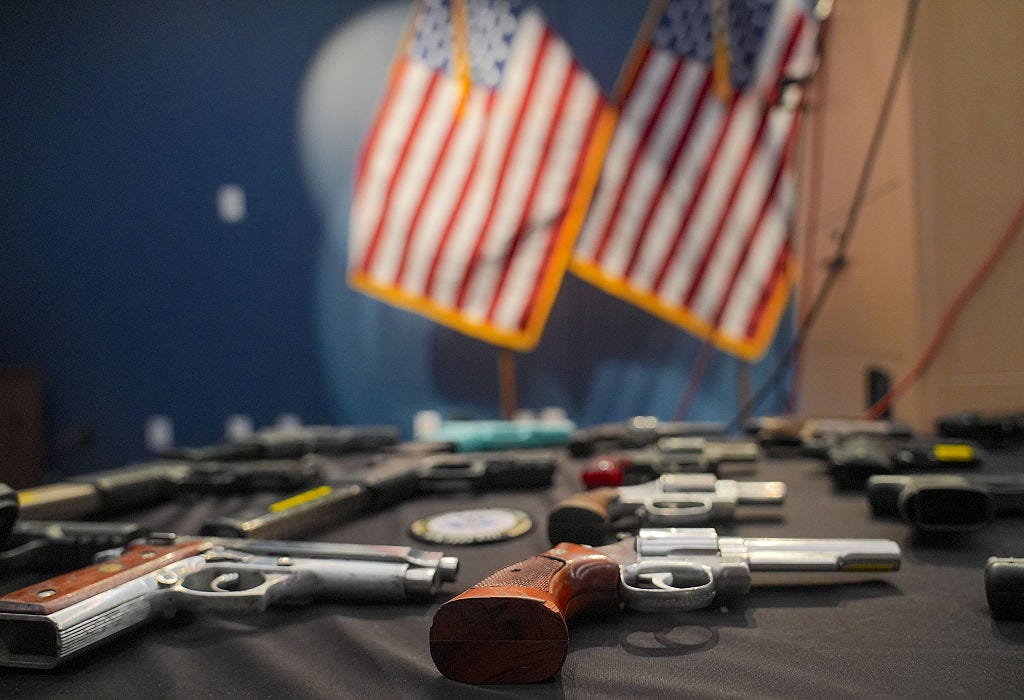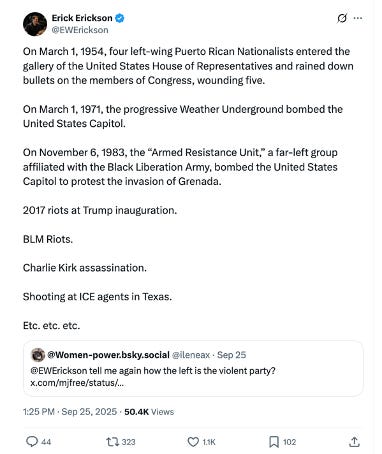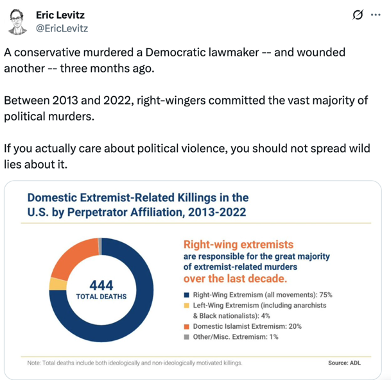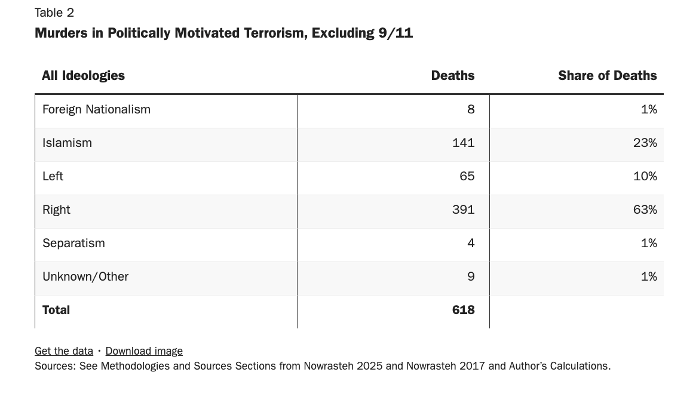Both the Far Left and the Far Right Make Excuses for Violence
You can’t just blame the rise of political terrorism on the other side.
The horrific murder of conservative activist Charlie Kirk on September 10 should have started a long-overdue conversation about the danger of political violence and of rhetoric that demonizes political opponents. Instead, all too predictably, it set off a cycle of finger-pointing and attempts to prove that violence is only—or primarily—a problem for the “other side.” And the Trump administration set the tone.
On the day of the shooting, Donald Trump blamed “the radical left” and its rhetoric before the shooter’s identity or motive was even known. Since then, he has explicitly and repeatedly stated that “the radicals on the left are the problem” and that “the violence comes largely from the left.” And, hosting Kirk’s podcast from the White House on September 15, Vice President JD Vance asserted that national reconciliation is impossible until Democrats and liberals not only agree that political violence is unacceptable but concede that “this is not a both sides problem”—that both support for political violence and political violence itself are “much bigger and [more] malignant” on the left.
Pundits on the right amplified this claim:
Meanwhile, some left-of-center commentators such as Vox’s Eric Levitz have countered with data purporting to show the exact opposite:
Who’s right? Should we see political violence as primarily a problem on one side—and which one?—or treat it as a danger across the board?
The real picture is complicated. If you set out to list only left-wing acts of political terrorism, as Erick Erickson does—especially if you reach all the way back to 1954—you can easily “prove” that it’s a left-wing problem. One could just as easily make a list that would inculpate solely the right: The 1963 Birmingham, Alabama church bombing targeting civil rights leaders; the 1984 murder of liberal talk show host Alan Berg by white supremacists; the 1995 bombing of the federal building in Oklahoma City by an ex-soldier turned far-right extremist; a series of deadly attacks on abortion providers; several massacres by perpetrators obsessed with the migrant “invasion”; July’s killing of Minnesota state legislator Melissa Hortman and her husband by an anti-abortion, anti-vaccine zealot.
The selective vision continues with regard to present-day events. Last week, a shooting at an Immigration and Customs Enforcement facility—which killed two detainees and injured one, but was clearly aimed at the agency itself—was quickly cited as more evidence of the left-wing peril. Meanwhile, some Trump critics recalled that less than a month earlier, a man obsessed with the supposed harms of the COVID vaccine opened a barrage of gunfire at the Centers for Disease Control and Prevention headquarters in Atlanta, Georgia, killing a police officer.
However, claims about the overwhelmingly right-wing nature of political violence such as the one made by Levitz, which relies on the Anti-Defamation League’s database of “domestic extremist-related killings,” warrant skepticism. The fine print on the ADL graphic Levitz reproduces notes that the numbers include “both ideologically and non-ideologically motivated killings.” In other words, the ADL counts all homicides by everyone classified as a political extremist—including homicides related to drugs, robberies, personal or family conflicts, and prison gang violence—even when mental illness is involved and even when the connection to extremism is tenuous.
In some cases, the ADL’s classifications raise well-founded questions about political bias. The organization’s report on extremist-related domestic murders in 2019 included a mentally ill man who killed his brother and who may have belonged to the far-right Proud Boys group, as well as a man who fatally shot his estranged girlfriend and, after his arrest, “reportedly said he was a sovereign citizen who did not recognize any government.” However, it left out Conor Betts’s shooting spree outside a Dayton, Ohio bar, which killed nine people and injured 17, due to insufficient evidence of extremism and lack of ideological motive. Yet Betts’s Twitter account showed ample evidence of left-wing radicalism and a fixation on righteous violence against “fascists,” “capitalists,” and other perceived oppressors.
A more rigorous dataset, limited to politically motivated killings, was compiled by Cato Institute fellow Alex Nowrasteh, with the following breakdown for the death toll from political terrorism in the United States over the last 50 years:
In this calculus, homicidal right-wing violence still substantially exceeds the left-wing kind, though both are thankfully rare.
An X user called “Recursion Agent” has challenged Nowrasteh’s analysis, claiming that it overcounts violence from the right and undercounts it on the left. The critique accurately flags some apparently misclassified cases and appropriately questions the non-inclusion of others (e.g. several killings linked to the racial protests and riots in the summer of 2020); but it also has its own obvious biases. Besides blatantly downplaying some perpetrators’ racist or far-right views, the thread critiques Nowrasteh for leaving out a “deranged lefty who annihilated his family” out of fear of being targeted by religious zealots—but makes no mention of family murders by people in the far-right QAnon cult.1
Such debates highlight the difficulty of classifying the politics of extremists, especially those whose ideologies may be a mishmash of conventionally “left” and “right” beliefs and who may suffer from mental illness. And there are other thorny questions. If racially motivated killings by whites are counted as right-wing extremism, should killings of whites by nonwhite perpetrators obsessed with racial oppression, such as 1993 Long Island Railroad shooter Colin Ferguson, count as left-wing extremism? Should the deaths during the 2020 racial unrest, mostly related to nonpolitical robberies but enabled by the chaos and violence of the riots, be added to the “left-wing extremism” body count? Should the casualties in the January 6 Capitol Hill attack, all rioters themselves, be added to that of right-wing extremism?
Evaluating public support for political violence can be just as tricky. In a September 10 YouGov poll, 16 percent of self-identified liberals and 24 percent of those self-describing as “very liberal” said that it was “usually or always” acceptable to feel joy about the death of a political opponent, compared to just four percent of self-identified conservatives and seven percent of moderates. Similar numbers agreed that resorting to violence to achieve political goals could sometimes be justified. These results were widely cited—among others, by Vance while hosting Kirk’s podcast—as evidence that approval for political violence is not a “both sides” issue but exists primarily on the left.
But caveats are in order. The survey was taken immediately after Kirk’s murder. As the YouGov report notes, the polling outfit’s earlier surveys show that both Democrats and Republicans are consistently more likely to regard political violence as a serious problem after a widely publicized attack on a figure from their “team.” And the way questions are phrased can also influence answers. For instance, when a poll in March formulated a question about political violence as, “Things have gotten so far off track, true American patriots may have to resort to violence in order to save our country,” one in five Trump supporters, but only one in ten Trump opponents, agreed.
Another recent survey seems reassuring in that it shows Democrats, Republicans (including “MAGA Republicans”) and independents all overwhelmingly oppose political violence. When asked if it was acceptable for citizens to use a variety of violent tactics to achieve their political goals, around 99 percent rejected politically motivated murder, assault, and arson, with negligible partisan differences well within the margin of error.
Should we conclude that there’s no problem? Not quite. For one thing, it’s easy to oppose political violence in theory; in practice, people often excuse it or hand-wave it when it’s on “their” side. For instance, in a 2024 YouGov poll, 60 percent of self-identified Trump supporters and 55 percent of all Republicans saw the January 6 Capitol Hill riot as an expression of “legitimate political discourse,” while only 18 and 20 percent respectively saw it as a “violent insurrection.” (The “discourse” included police officers being pepper-sprayed, punched, kicked, and beaten with flag poles and fire extinguishers; some 140 were injured, with one officer suffering a fatal stroke shortly after being manhandled by the crowd.)
Democrats have their own blind spots. During the 2020 Black Lives Matter protests following George Floyd’s murder, liberal publications such as Slate, The Atlantic and The New Republic published excuses for rioting as an expression of black anger and frustration. (In fact, quite a few black activists condemned the violence as the work of attention-seeking white anarchists.) Today, many liberals tend to fall back on claims that the 2020 protesters were “mostly peaceful.” But while this was true of most protests—of which there were over 7,000 nationwide—nearly 550 events did involve serious violence and/or property damage. At least 30 people died, excluding those killed by law enforcement; some 900 police officers were reportedly injured, and many city blocks were devastated, with damage totaling between $1 and $2 billion.
Both sides are also inclined to try to pin acts of violence on the other side. We just saw this with attempts by many on the left to claim that Charlie Kirk’s killer was a member of the extreme right. But at least people left of center (other than the far left) tend to believe reporting by the mainstream media. On the right, even people who are not particularly extreme can be found parroting false narratives reassigning right-wing violent extremists to the left. One routinely encounters assertions that the killer of Hortman, the Minnesota lawmaker, was not a Trump supporter but a leftist angry at Hortman for voting with Republicans on an immigration bill (a claim debunked by The Blaze, a strongly conservative website).2 And even Ted Cruz has amplified the claim that the 2022 attack on former Democratic House Speaker Nancy Pelosi’s husband was carried out by a “hippie nudist leftist” with no connection to the right. In fact, the attacker, David DePape, had once been involved in progressive activism but had since become immersed in far-right, MAGA-adjacent conspiracies including QAnon.
So, is violence more inherent to one ideology? One can certainly point (as conservative British pundit Douglas Murray does in City Journal) to the American left’s history of sympathy for violent radicals such as the Weather Underground or the Black Panthers. In a fresh, shameful example of this mindset, the Democratic Socialists of America (a group with ties to a number of progressive Democrats) and the Chicago Teachers’ Union both made posts honoring Assata Shakur, a member of a violent black liberation group who died in Cuba where she escaped after being convicted of killing a New Jersey police officer in 1973.
But the nationalist right has its own history of support for violent methods—from rhetoric suggesting that the right of gun ownership authorizes armed resistance to leftist tyranny to sympathy for dictatorships such as that of Chile’s Augusto Pinochet. (Ironic references to the Pinochet regime’s practice of killing undesirables by dropping them in the ocean from helicopters have become a popular right-wing meme.) If the left-wing call to fight oppression and “hate” can become a justification for violence, so can the right-wing call to fight the “enemy within,” be it foreign “invaders” or homegrown “Marxists.” Secretary of War Pete Hegseth has, for instance, routinely employed rhetoric in his books that treats liberals as a domestic enemy—and sometimes suggested that the fight against them may yet become a literal war.
The truth is that the dominant ideological tenor of political violence is not a constant. It was primarily left-wing in the late 1960s and 1970s, predominantly right-wing in the 1980s and onward; today, terrorism experts Daniel Byman and Riley McCabe write in The Atlantic, we seem to be seeing a swing toward more violence from the left. But that may change again, especially if more people on the right get the message that “it’s war.”
Thankfully, so far, the overall levels of political violence in the United States remain fairly low. But the danger signs are there: in a just-released NPR/Marist poll, 30 percent of Americans—up from 20 percent in March 2024—agree that “Americans may have to resort to violence in order to get the country back on track.” (While Republicans are more likely to endorse this statement, the most dramatic growth in agreement—from 12 percent to 28 percent—has been among Democrats.)
In this climate, reducing the temperature of political rhetoric is essential. Using the issue to score political points against the other side won’t get us there. The only answer is to stick to the facts—and, above all, to hold one’s own “team” accountable when necessary.
Cathy Young is a writer at The Bulwark, a columnist for Newsday, and a contributing editor to Reason.
Follow Persuasion on Twitter, LinkedIn, and YouTube to keep up with our latest articles, podcasts, and events, as well as updates from excellent writers across our network.
And, to receive pieces like this in your inbox and support our work, subscribe below:
“Recursion Agent” also criticizes Nowrasteh both for counting “crazies” on the right (e.g. a mentally ill anti-abortion crusader who went on a shooting spree at a Planned Parenthood clinic in 2015) and for not counting mentally disturbed killers who may have been on the left.
This narrative is partly sustained by the fact that the suspect, Vance Boelter, was reappointed by Democratic Governor Tim Walz to the Minnesota Governor’s Workforce Development Board; but the board is one of many bipartisan advisory bodies. Boelter was, in fact, a Trump voter.









Had to come to the comments section to see how Frank Lee spun this rather balanced article. He did not disappoint.🥴
Individuals on both sides commit violence, but has the right (even far right) ever openly celebrated murdered Americans like we've seen repeatedly from the left in just the past 12 months?
Violence is a both sides issue. Justifying and normalizing it is not.